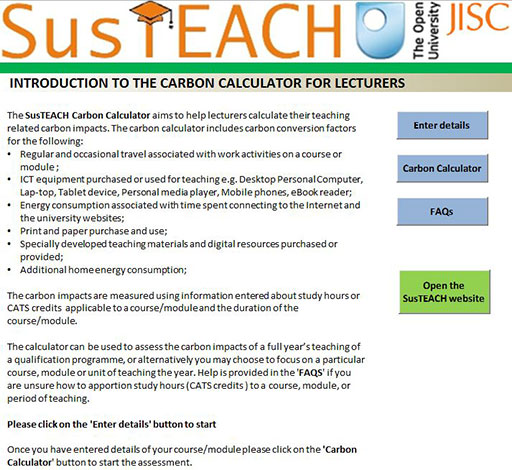3.1.3 Exploring the SusTEACH Carbon Calculator for Lecturers
Here you will explore the Carbon Calculator for Lecturers, which has a similar design to the Carbon Calculator for Students.
SAQ 5
Explore the SusTEACH Carbon Calculator for Lecturers to calculate the energy consumption and carbon impacts of your teaching activities on a course.
Download or open the SusTEACH Carbon Calculator for Lecturers [Tip: hold Ctrl and click a link to open it in a new tab. (Hide tip)] in Microsoft Excel.
You should find the tools easy to use, but the user guide is available to help you to navigate through the tool if you need additional help.
Answer
The SusTEACH Carbon Calculator for Lecturers helps you to calculate the energy consumption and carbon impacts associated with your teaching activities on a course using the measure per student per 100 study hours/10 CATS credits.
You can compare the results of your calculation with an example in Box 4.
Box 4 Using the Carbon Calculator to assess carbon impacts associated with teaching on a course
Emma is a lecturer on a course that provides 100 study hours (10 CATS credits) to 100 students at a campus-based university, and this takes place over a ten-week period. During an academic year she spends 20 per cent of her time on the preparation, administration, teaching and assessment of this course.
She makes 27 regular journeys from her home residence, covering a round trip distance of 25 miles to the university campus using a diesel car (with a 1.3–1.6 litre engine). She also makes two journeys on field trips, covering a round trip distance of 40 miles by express coach. All of this travel is associated with the course rather than other work activities.
Emma purchased a laptop and uses this for seven hours per week for course-related work. She did not use the laptop outside the campus building; consequently, all of the energy consumption associated with that use is separately captured in the energy data associated with campus site operations. She also buys one book and uses 100 sheets of paper in a typical week to support course preparations, administration, teaching and tutoring.
Using the calculator, Emma’s carbon impacts as a lecturer are estimated at 1 kg CO2 per student per 100 hours/10 CATS credits. This relatively low impact is mainly due to the large number of students taking the course. If the student numbers were quartered to 25 students, then her carbon impacts using the ‘per student’ measure would be quadrupled.
This example shows that it is important to consider the measures used in Carbon Calculators. The SusTEACH Carbon Calculator for Lecturers divides the lecturer’s energy consumption and carbon impacts by the number of students on a course to calculate the impacts using the ‘per student’ measure. This means that when there is a greater number of students on the course benefiting from the lecturer’s activities to deliver the teaching, learning and assessment provision, there are efficiencies of scale using the ‘per student’ measure.
As a lecturer, you may prefer to use a ‘per lecturer’ measure rather than the ‘per student’ measure, as this would allow you to see a greater difference to your carbon impacts if you decided to change some of your teaching-related activities. The ‘per student’ measure however, allows you to combine data collected from students and lecturers on a course. It also helps to consider the efficiencies of scale when there are larger numbers of students on courses which are also related to economies of scale.

